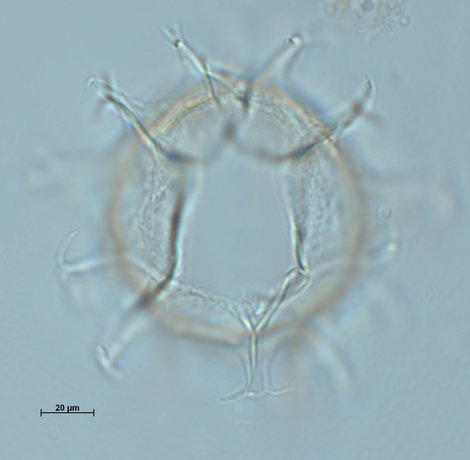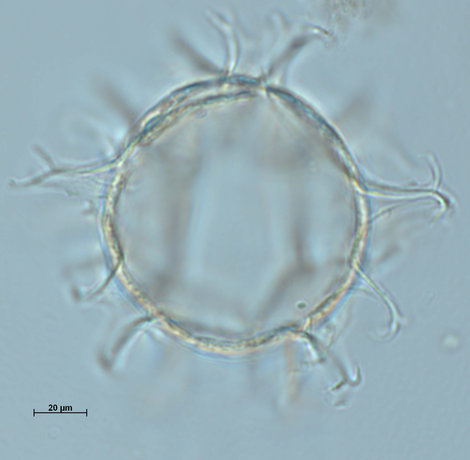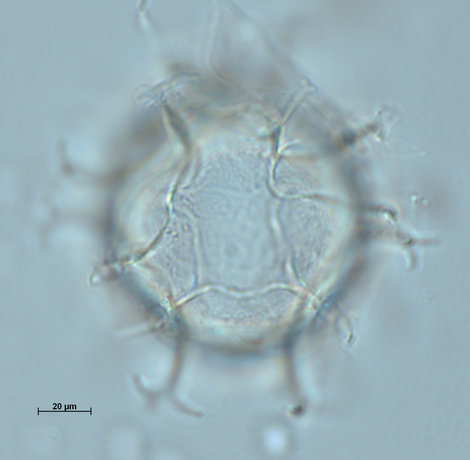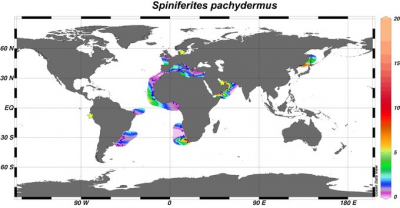Page path:
- Modern Dinocyst Key
- transparent cysts
- Septa and processes
- other cysts with septa and processes
- without apical nodge
- Spiniferites pachydermus
Spiniferites pachydermus
Zonneveld, K.A.F. and Pospelova V. (2015). A determination key for modern dinoflagellate cysts. Palynology 39 (3), 387- 407.

dorsal view
single grain - reference collection Bremen
Sample GeoB xxxxxxx
eastern equatorial Atlantic off NW Africa
photographs: Karin Zonneveld
single grain - reference collection Bremen
Sample GeoB xxxxxxx
eastern equatorial Atlantic off NW Africa
photographs: Karin Zonneveld

cross section

ventral view
Field characteristics
Spiniferites pachydermus (Rossignol 1964) Reid 1974 Plate 6, Fig. 7.
Field characteristics:
Proximochorate spherical to subspherical cyst with a microgranulate to reticulate wall and low apical boss. Tabulation is expressed by low sutural septa and only gonal trifurcate processes with bifid terminations. Archeopyle is precingular (type P).
Dimensions: Cyst body: 33 to 37 (width) x 44 to 54 (length) µm; maximum length of processes: 19 µm.
Motile affinity: Probably a cyst of Gonyaulax spp.
Stratigraphic range: Pleistocene to Recent.
Comparison with other species:
The main characteristic is that this species has very thick wall with a tectate appearance.
Field characteristics:
Proximochorate spherical to subspherical cyst with a microgranulate to reticulate wall and low apical boss. Tabulation is expressed by low sutural septa and only gonal trifurcate processes with bifid terminations. Archeopyle is precingular (type P).
Dimensions: Cyst body: 33 to 37 (width) x 44 to 54 (length) µm; maximum length of processes: 19 µm.
Motile affinity: Probably a cyst of Gonyaulax spp.
Stratigraphic range: Pleistocene to Recent.
Comparison with other species:
The main characteristic is that this species has very thick wall with a tectate appearance.
Geographic distribution
Geographic distribution based on :
Zonneveld et al., 2013. Atlas of modern dinoflagellate cyst distribution based on 2405 datapoints. Review of Palaeobotany and Palynology, v. 191, 1-197
Zonneveld et al., 2013. Atlas of modern dinoflagellate cyst distribution based on 2405 datapoints. Review of Palaeobotany and Palynology, v. 191, 1-197
Spiniferites pachydermus has a temperate to equatorial mainly coastal distribution restricted to full marine environments with relatively high upper water nitrate concentrations and bottom waters that are well ventilated. Highest relative abundances occur in mesotrophic to eutrophic environments in upwelling regions in the vicinity of upwelling cells.

Distribution:
Spiniferites pachydermus is restricted to temperate to equatorial coastal regions along the margins of the Atlantic Oceans, Mediterranean Sea, Arabian Sea and northwestern Pacific. Here full marine conditions prevail throughout the year. High abundances > 5% (up to 16%) occur in the Benguela upwelling area (southeastern South Atlantic), the Arabian Sea and the Sea of Japan. It has not been observed where nitrate is low in the surface waters.
Environmental parameter range:
SST: 0 - 29.0°C with summer SST 10.7°C except for two sites in the northwestern Pacific Ocean where winter SST: -0.8°C. SSS: 27.8 - 39.0 (spring - autumn), [P]: 0.06 - 1.00 μmol/l, [N]: 0.2 - 12.0 μmol/l, chlorophyll-a: 0.08 - 20.0 ml/l, bottom water [O2]: 1.1 - 6.0 ml/l.
Highest relative abundances of Spiniferites pachydermus occur where (seasonally) mesotrophic to eutrophic conditions occur including upwelling areas, which may have large inter-annual variability in the trophic state of the upper waters.
Comparison with other records:
Apart from the records in the dataset of this Atlas, Spiniferites pachydermus has been observed in surface sediments of coastal sites of the Swedish coast, the Persian Gulf and the upwelling area off Peru (eastern equatorial Pacific, Bradford, 1975; Biebow et al., 1993; Persson et al., 2000a). In sediment trap studies it is only registered in the Arabian Sea where highest relative abundances were observed during upwelling relaxation but the cyst production was not restricted to a certain season (Zonneveld and Brummer, 2000).
Spiniferites pachydermus is restricted to temperate to equatorial coastal regions along the margins of the Atlantic Oceans, Mediterranean Sea, Arabian Sea and northwestern Pacific. Here full marine conditions prevail throughout the year. High abundances > 5% (up to 16%) occur in the Benguela upwelling area (southeastern South Atlantic), the Arabian Sea and the Sea of Japan. It has not been observed where nitrate is low in the surface waters.
Environmental parameter range:
SST: 0 - 29.0°C with summer SST 10.7°C except for two sites in the northwestern Pacific Ocean where winter SST: -0.8°C. SSS: 27.8 - 39.0 (spring - autumn), [P]: 0.06 - 1.00 μmol/l, [N]: 0.2 - 12.0 μmol/l, chlorophyll-a: 0.08 - 20.0 ml/l, bottom water [O2]: 1.1 - 6.0 ml/l.
Highest relative abundances of Spiniferites pachydermus occur where (seasonally) mesotrophic to eutrophic conditions occur including upwelling areas, which may have large inter-annual variability in the trophic state of the upper waters.
Comparison with other records:
Apart from the records in the dataset of this Atlas, Spiniferites pachydermus has been observed in surface sediments of coastal sites of the Swedish coast, the Persian Gulf and the upwelling area off Peru (eastern equatorial Pacific, Bradford, 1975; Biebow et al., 1993; Persson et al., 2000a). In sediment trap studies it is only registered in the Arabian Sea where highest relative abundances were observed during upwelling relaxation but the cyst production was not restricted to a certain season (Zonneveld and Brummer, 2000).


